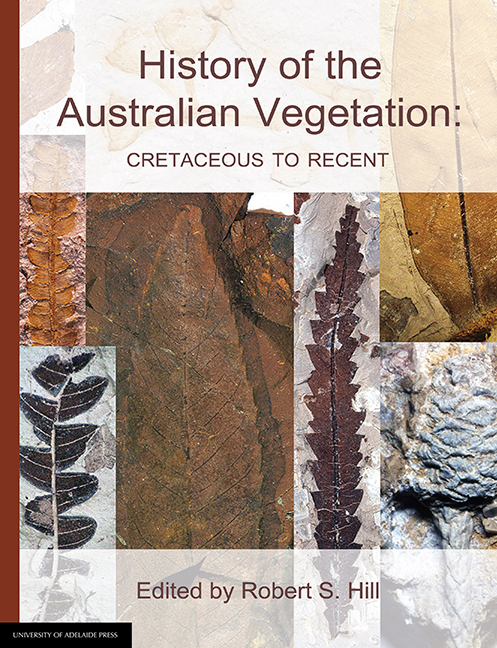Book contents
- Frontmatter
- Contents
- List of contributors
- Introduction to the 2017 edition
- 1 The Australian fossil plant record: an introduction
- 2 Maps of late Mesozoic-Cenozoic Gondwana break-up: some palaeogeographical implications
- 3 The background: 144 million years of Australian palaeoclimate and palaeogeography
- 4 Palaeobotanical evidence for Tertiary climates
- 5 Landscapes of Australia: their nature and evolution
- 6 Patterns in the history of Australia's mammals and inferences about palaeohabitats
- 7 Australian Tertiary phytogeography: evidence from palynology
- 8 Cretaceous vegetation: the microfossil record
- 9 Cretaceous vegetation: the macrofossil record
- 10 Early Tertiary vegetation: evidence from spores and pollen
- 11 The early Tertiary macrofloras of continental Australia
- 12 Cenozoic vegetation in Tasmania: macrofossil evidence
- 13 The Neogene: a period of transition
- 14 The Oligo-Miocene coal floras of southeastern Australia
- 15 Quaternary vegetation
- 16 The history of selected Australian taxa
- Taxonomic index
- General index
14 - The Oligo-Miocene coal floras of southeastern Australia
Published online by Cambridge University Press: 25 July 2017
- Frontmatter
- Contents
- List of contributors
- Introduction to the 2017 edition
- 1 The Australian fossil plant record: an introduction
- 2 Maps of late Mesozoic-Cenozoic Gondwana break-up: some palaeogeographical implications
- 3 The background: 144 million years of Australian palaeoclimate and palaeogeography
- 4 Palaeobotanical evidence for Tertiary climates
- 5 Landscapes of Australia: their nature and evolution
- 6 Patterns in the history of Australia's mammals and inferences about palaeohabitats
- 7 Australian Tertiary phytogeography: evidence from palynology
- 8 Cretaceous vegetation: the microfossil record
- 9 Cretaceous vegetation: the macrofossil record
- 10 Early Tertiary vegetation: evidence from spores and pollen
- 11 The early Tertiary macrofloras of continental Australia
- 12 Cenozoic vegetation in Tasmania: macrofossil evidence
- 13 The Neogene: a period of transition
- 14 The Oligo-Miocene coal floras of southeastern Australia
- 15 Quaternary vegetation
- 16 The history of selected Australian taxa
- Taxonomic index
- General index
Summary
This chapter presents the results of the authors’ separate and conjoint studies of the palaeobotany, stratigraphy and palaeoecology of the Latrobe Valley Coal Measures, a thick sequence of coal seams and interseam elastics in the Gippsland region of southeastern Australia (Figure 14.1).
The Latrobe Valley Coal Measures are of Middle Eocene-Middle Miocene age and were deposited after the separation of Australia from Antarctica, a time of significant climatic change for the Australian continent and a period during which major global changes in sea levels and climates occurred. The Eocene-Miocene was an important time for the development of the modern Australian flora and the Latrobe Valley Coal Measures provide a window into this critical period. The study of the fossil assemblages of the coals has led to a detailed understanding of the vegetation that formed the coal measures and contributes significantly to our knowledge of the development of the modern Australian flora.
Previous workers have directed their efforts to particular aspects of the nature and relationships of the coal swamp vegetation. Early workers (Chapman, I925a,b; Deane, 1925; Cookson, 1946, 1947, 1950, 1953, 1957, 1959; Cookson & Duigan, 1950, 1951; Cookson & Pike, 1953a,b; 1954a,b; Pike, 1953; Patton, 1958) concentrated upon the taxonomic affinities of macroscopic and microscopic plant remains. Duigan (1966) studied selected micro- and macrofossil plant taxa from a palaeogeographical, ecological and evolutionary viewpoint. Baragwanath & Kiss (1964), Partridge (1971) and Stover & Partridge (1973) were more concerned with establishing stratigraphic relationships with the microfossils. The last of these studies, of pollen and marine microfossils, developed a long-accepted biostratigraphy for the basin.
Recently the biostratigraphy has been revised using more extensive sampling and better correlation with the geology of the basin (Haq et al., 1987; Holdgate, 1985, 1992; Holdgate & Sluiter, 1991). These studies also demonstrated the significance of eustatic sea level changes in influencing sedimentation within the basin and also that significant marine transgressions can be traced in both the lithofacies and the microfossil record.
- Type
- Chapter
- Information
- History of the Australian VegetationCretaceous to Recent, pp. 328 - 367Publisher: The University of Adelaide PressPrint publication year: 2017

